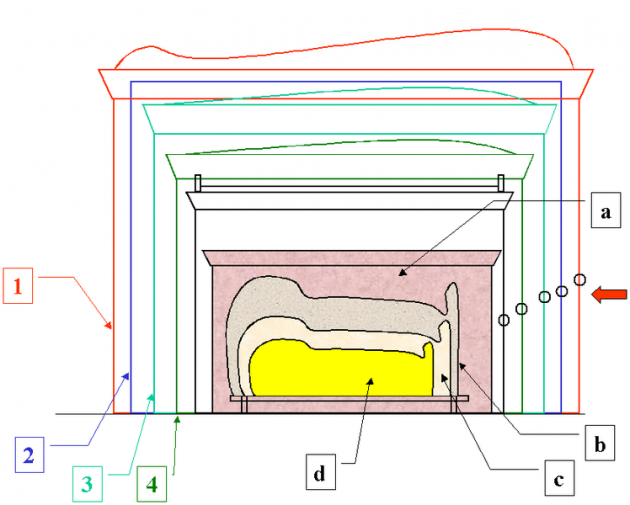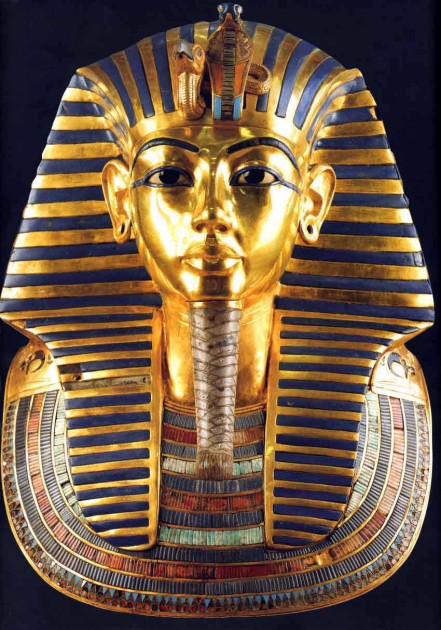Wednesday, June 6th, 2012
King Tut: Nesting Shrines, a Sarcophagus, and Coffins
Last weekend I had the opportunity to visit an amazing exhibit on King Tutankhamun (see some images from the show here). I’ve always been interested in King Tut (I’ve blogged about him before), and I’ve been anticipating the opening of this exhibition for a long time. Upon entering the exhibit space, I was really pleased to see that the show wasn’t limited to objects found in King Tut’s tomb, but included sculptures and artifacts from the Old Kingdom and New Kingdom. In fact, one of the colossal statues of Ankhenaten also was there, which was neat to see.
One of the things that I found particularly interesting was a short video clip by National Geographic. The clip recreated how all the different nesting shrines, sarcophagus, and coffins covered King Tut’s body.
I already knew that several coffins covered King Tut’s body, but I wasn’t aware of how many shrines were used to cover the sarcophagus. All together, the shrines, sarcophagus and coffins totaled the number nine: the Egyptian number which symbolized infinity. I’ve recreated a list of the different shrines, sarcophagus and coffins below, going in order from the outermost shrine. (On a side note: You would be surprised to know how many conflicting stories exist online about King Tut’s shrines, sarcophagus and coffins! It has taken me forever to sort out the correct information.)

Cross-section diagram of shrines, sarcophagus, and nesting coffins for King Tutankhamun’s mummy. Courtesy Hotepibre via Wikipedia.
- Outermost Golden Shrine: This shrine, which housed all of the remaining shrines, sarcophagus, coffins and mummy, almost filled the entire room of King Tut’s tomb. It is about nine feet high and sixteen feet long. The shrine is decorated with the double-tiered knot of Isis and the djed (the backbone of Osiris, representing stability). There also are hieroglyphs of Osiris on the case. This shrine is on display in the Cairo Museum. A virtual tour of this shrine (and the second and third shrines) is found HERE.
- The Pall Frame: This is a nine-piece gabled framework. It is made out of wood and gold. On top of the framework was a fabric that was decorated with large marguerites (daisy-like flowers) of gilded bronze. One commenter described the fabric as “like a night sky spangled with stars.” Unfortunately, the fabric was ruined when it was left out in the open, during a period when Carter’s American team was prevented from working in the tomb and laboratory.
- The Second Shrine (also see drawing here): This second shrine is made out of gold and is decorated with funerary texts from the book of the dead. This particular shrine has a sloping roof and is thought to be in the shape of the Per-Wer, the ancient shrine of Upper Egypt that once housed a cult image of the tutelary goddess Nekhbet. This shrine was constructed by sixteen separate pieces, which allowed the shrine to be assembled on-site in the burial chamber (a process likely confirmed by the assembling directions written in black ink on several individual pieces). Domestic, magical, and ornate objects were placed in the available space between this shrine, the third shrine, and the fourth shrine.
- The Third Shrine: This shrine is very similar to the second shrine, only with smaller dimensions. This shrine is also made out of gold and has a sloping roof. Likewise, the third shrine also is decorated with funerary texts from the Book of the Dead.
- The Fourth (Innermost) shrine (also see drawing): The sides of the shrine depict a procession of various gods, including Anubis and Horus. The sky goddess Nut was depicted on the top of the ceiling, embracing the sarcophagus with her wings. The interior walls depict Spell 17 from the Book of the Dead.
- Sarcophagus (also see drawing): This sarcophagus was made out of quartzite (for the body of the sarcophagus) and was supported by a block of alabaster. The lid was made out of red granite. The lid doesn’t quite match the sarcophagus (and furthermore, was cracked and then repaired with gypsum!), which might suggest that the intended lid was not created in time for the hurried burial. The whole sarcophagus itself weighed over a ton.
- Outermost Coffin: Like the other two coffins, this coffin was wrapped in linen. This anthropoid coffin depicted an image of the king. The coffin was made out of gilded wood and cut stones. Four silver handles were created to lower the coffin into the sarcophagus. When containing the other nested coffins, this outermost coffin weighed 1.36 metric tons (3,000 pounds).
- Second (Middle) Coffin (see photo of a museum display that compares of smaller second coffin with outermost gold coffin): This anthropoid coffin is made out of gilded wood. Small pieces of colored glass were affixed to practically the whole body of the coffin. It was protected by a red linen shroud when it was discovered by Howard Carter. Additionally, the red linen shroud was covered with floral garlands. The flowers, although far dead and dry, suggest that the king was buried during the spring time when the flowers would have been available. No handles exist on this middle coffin, which made the excavation difficult.
- Innermost Coffin (see detail image HERE): This anthropoid coffin was made of pure gold, inlaid with glass and semi-precious stones. When it was discovered, this coffin originally was covered in a sticky black residue, made from a perfume. The coffin is just over six feet tall and weighs nearly 243 pounds. Gold handles are located on this innermost coffin.
- The mummy of King Tut, with the head protected by a funerary mask of gold, lapis lazuli, glass, and semi-precious stones. The mask weighs 24 pounds (11 kg). Gold sandals were placed on the mummy’s feet, along with various other decorative objects on the body. The king’s fingers were lined with hollow gold finger tips.
On a side note, apart from these nested shrines, sarcophagus, and coffins, there also was another separate shrine located in King Tut’s tomb: the canopic shrine. You can watch a video about King Tut’s canopic shrine HERE. Inside the shrine there was a canopic chest and small canopic “coffinettes” which contained some of King Tut’s vital organs. (THIS ONE contained King Tut’s liver.)
Although ancient thieves entered King Tut’s tomb relatively soon after the pharaoh’s burial, afterward the tomb remained undisturbed for several centuries. And since thieves never touched King Tut’s actual sarcophagus (the seal on the second and third shrines were intact upon discovery), we have been able to better understand the burial process and some of the funerary objects for Egyptian pharaohs. However, it blows my mind to think about what luxurious coffins and objects were placed inside the tombs of more prestigious kings. As a relatively insignificant pharaoh who died at a young age, King Tut apparently received a more modest burial than other Egyptian rulers. One can only imagine what riches were taken by the ancient thieves that disturbed some of the other tombs!


Oh man this post is great! I’ve gotten so frustrated in the past trying to figure out what the different layers were exactly. Really glad you included links to pictures too.
Have you ever looked up his family tree? It’s pretty great. It’s maybe not Hapsburg great, but still pretty disgusting! Also this is probably common knowledge, but I just learned not too long ago that two mummified fetuses or stillborn babies were found in his tomb (his kids?). I find that interesting for some reason.
I’m glad that you found the post helpful, Josh! It was helpful for me to write, especially since there is so much conflicting or confusing information out there.
Yeah, King Tut’s family tree is pretty insane. There was a great article in National Geographic a few years ago that talked about King Tut’s family tree. There were some DNA tests done on different mummies, to prove that King Tut was the son of Ankhenaten and Ankenaten’s sister! No wonder King Tut had a club foot and all of these different health problems: his parents were siblings!
The exhibition that I attended had some object associated with the two fetuses – I think they were coffins, if I remember right. Yeah, it is pretty crazy to think that King Tut might have been buried with his children, especially since he was so young himself.
M:
For the summer try reading Emmanuel Velikovsky’s “Oedipus and Akhnaten” for the incredible story of the tragic pharaoh and King Tut.
Frank
looks amazing! we’re going up there at some point this summer to see it. Celia will be in HEAVEN…